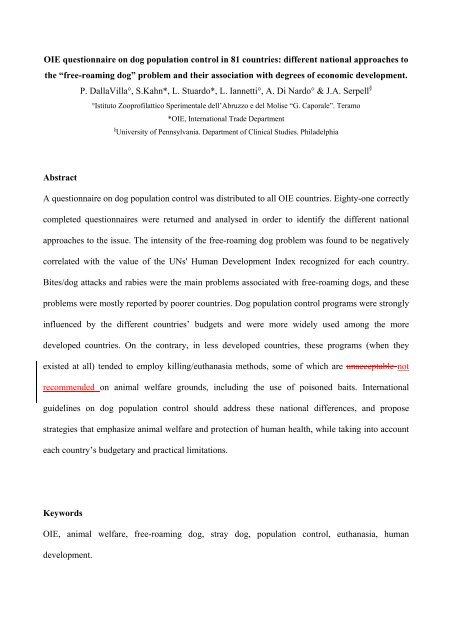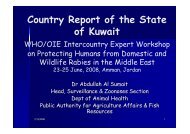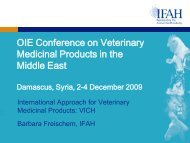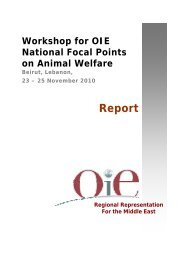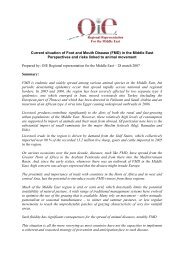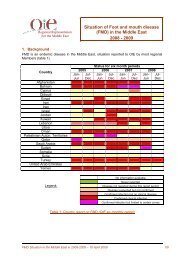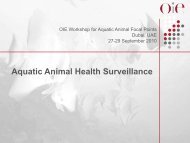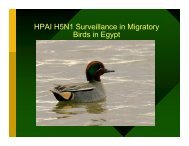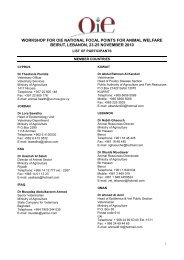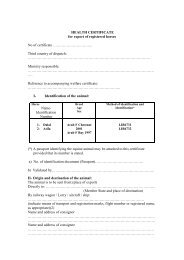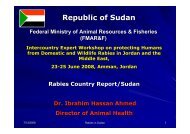OIE questionnaire on dog population control in ... - Middle East - OIE
OIE questionnaire on dog population control in ... - Middle East - OIE
OIE questionnaire on dog population control in ... - Middle East - OIE
You also want an ePaper? Increase the reach of your titles
YUMPU automatically turns print PDFs into web optimized ePapers that Google loves.
<str<strong>on</strong>g>OIE</str<strong>on</strong>g> <str<strong>on</strong>g>questi<strong>on</strong>naire</str<strong>on</strong>g> <strong>on</strong> <strong>dog</strong> populati<strong>on</strong> c<strong>on</strong>trol <strong>in</strong> 81 countries: different nati<strong>on</strong>al approaches tothe “free-roam<strong>in</strong>g <strong>dog</strong>” problem and their associati<strong>on</strong> with degrees of ec<strong>on</strong>omic development.P. DallaVilla°, S.Kahn*, L. Stuardo*, L. Iannetti°, A. Di Nardo° & J.A. Serpell §°Istituto Zooprofilattico Sperimentale dell’Abruzzo e del Molise “G. Caporale”. Teramo*<str<strong>on</strong>g>OIE</str<strong>on</strong>g>, Internati<strong>on</strong>al Trade Department§ University of Pennsylvania. Department of Cl<strong>in</strong>ical Studies. PhiladelphiaAbstractA <str<strong>on</strong>g>questi<strong>on</strong>naire</str<strong>on</strong>g> <strong>on</strong> <strong>dog</strong> populati<strong>on</strong> c<strong>on</strong>trol was distributed to all <str<strong>on</strong>g>OIE</str<strong>on</strong>g> countries. Eighty-<strong>on</strong>e correctlycompleted <str<strong>on</strong>g>questi<strong>on</strong>naire</str<strong>on</strong>g>s were returned and analysed <strong>in</strong> order to identify the different nati<strong>on</strong>alapproaches to the issue. The <strong>in</strong>tensity of the free-roam<strong>in</strong>g <strong>dog</strong> problem was found to be negativelycorrelated with the value of the UNs' Human Development Index recognized for each country.Bites/<strong>dog</strong> attacks and rabies were the ma<strong>in</strong> problems associated with free-roam<strong>in</strong>g <strong>dog</strong>s, and theseproblems were mostly reported by poorer countries. Dog populati<strong>on</strong> c<strong>on</strong>trol programs were str<strong>on</strong>gly<strong>in</strong>fluenced by the different countries’ budgets and were more widely used am<strong>on</strong>g the moredeveloped countries. On the c<strong>on</strong>trary, <strong>in</strong> less developed countries, these programs (when theyexisted at all) tended to employ kill<strong>in</strong>g/euthanasia methods, some of which are unacceptable notrecommended <strong>on</strong> animal welfare grounds, <strong>in</strong>clud<strong>in</strong>g the use of pois<strong>on</strong>ed baits. Internati<strong>on</strong>alguidel<strong>in</strong>es <strong>on</strong> <strong>dog</strong> populati<strong>on</strong> c<strong>on</strong>trol should address these nati<strong>on</strong>al differences, and proposestrategies that emphasize animal welfare and protecti<strong>on</strong> of human health, while tak<strong>in</strong>g <strong>in</strong>to accounteach country’s budgetary and practical limitati<strong>on</strong>s.Keywords<str<strong>on</strong>g>OIE</str<strong>on</strong>g>, animal welfare, free-roam<strong>in</strong>g <strong>dog</strong>, stray <strong>dog</strong>, populati<strong>on</strong> c<strong>on</strong>trol, euthanasia, humandevelopment.
1Introducti<strong>on</strong>23456789101112131415161718192021Free-roam<strong>in</strong>g <strong>dog</strong>s are a worldwide problem, and a number of different programs have beenimplemented by competent authorities and NGOs to manage them. Serious public health c<strong>on</strong>cernsarise from this issue: Dog bites and attacks cause significant numbers of hospitalisati<strong>on</strong>s each yearall over the world (De Keuster & Butcher 2008, Morgan & Palmer 2007, Georges & Adesiyun2008), while rabies and other zo<strong>on</strong>oses (such as leishmaniasis) f<strong>in</strong>d important reservoirs <strong>in</strong>unc<strong>on</strong>trolled stray <strong>dog</strong> populati<strong>on</strong>s (<str<strong>on</strong>g>OIE</str<strong>on</strong>g> 2007, Cortes et al. 2007). For ethical, ecological, andec<strong>on</strong>omic reas<strong>on</strong>s it is no l<strong>on</strong>ger acceptable to c<strong>on</strong>trol and eradicate disease outbreaks ma<strong>in</strong>ly byapply<strong>in</strong>g mass kill<strong>in</strong>g of animals (<str<strong>on</strong>g>OIE</str<strong>on</strong>g> 2005). Even if the <str<strong>on</strong>g>OIE</str<strong>on</strong>g> (World Organizati<strong>on</strong> for AnimalHealth) recognises the importance of c<strong>on</strong>troll<strong>in</strong>g stray <strong>dog</strong> populati<strong>on</strong>s (<str<strong>on</strong>g>OIE</str<strong>on</strong>g> 2007), the extent towhich c<strong>on</strong>trol programs are present with<strong>in</strong> the member countries depends <strong>on</strong> local attitudes to freeroam<strong>in</strong>g<strong>dog</strong>s and the availability of f<strong>in</strong>ancial resources and veter<strong>in</strong>ary <strong>in</strong>puts to deal with theproblem. S<strong>in</strong>ce there is undoubtedly a correlati<strong>on</strong> between the level of development of a countryand its capacity to manage stray <strong>dog</strong> populati<strong>on</strong>s, <strong>in</strong>ternati<strong>on</strong>al guidel<strong>in</strong>es <strong>on</strong> <strong>dog</strong> populati<strong>on</strong> c<strong>on</strong>trolshould c<strong>on</strong>sider these nati<strong>on</strong>al differences, and suggest diverse strategies that accommodate localand nati<strong>on</strong>al needs and limitati<strong>on</strong>s.The aim of this study was to analyse the results of a <str<strong>on</strong>g>questi<strong>on</strong>naire</str<strong>on</strong>g>, developed by the <str<strong>on</strong>g>OIE</str<strong>on</strong>g> adhoc group <strong>on</strong> Dog Populati<strong>on</strong> C<strong>on</strong>trol, and sent to all <str<strong>on</strong>g>OIE</str<strong>on</strong>g> Members, <strong>in</strong> order to assess the currentsituati<strong>on</strong> with respect to free-roam<strong>in</strong>g <strong>dog</strong>s <strong>in</strong> <str<strong>on</strong>g>OIE</str<strong>on</strong>g> Member countries and territories throughout theworld, and to obta<strong>in</strong> <strong>in</strong>formati<strong>on</strong> <strong>on</strong> the different approaches used for <strong>dog</strong> populati<strong>on</strong> c<strong>on</strong>trol.2223Materials and methods24
252627282930313233343536Questi<strong>on</strong>naire designA <str<strong>on</strong>g>questi<strong>on</strong>naire</str<strong>on</strong>g> <strong>on</strong> <strong>dog</strong> populati<strong>on</strong> c<strong>on</strong>trol, written <strong>in</strong> Microsoft Word format and translated <strong>in</strong>to thethree <str<strong>on</strong>g>OIE</str<strong>on</strong>g> official languages (English, French, Spanish), was sent to all <str<strong>on</strong>g>OIE</str<strong>on</strong>g> Members via e-mail.Official resp<strong>on</strong>ses were provided by the State Veter<strong>in</strong>ary Services. The survey comprised 17questi<strong>on</strong>s, divided <strong>in</strong>to two secti<strong>on</strong>s: “I. General Informati<strong>on</strong> <strong>on</strong> the <strong>dog</strong> populati<strong>on</strong>” (questi<strong>on</strong>sabout the presence of free roam<strong>in</strong>g <strong>dog</strong>s and associated problems, the distributi<strong>on</strong> of stray <strong>dog</strong>s <strong>in</strong>urban and rural and areas and wildlife reserves, and the k<strong>in</strong>ds of problems produced by thispresence), and “II. Stray Dog C<strong>on</strong>trol” (questi<strong>on</strong>s about the presence of official <strong>dog</strong> populati<strong>on</strong>c<strong>on</strong>trol programmes, and the different methods of c<strong>on</strong>trol employed). As appropriate to the type ofquesti<strong>on</strong>, answers were multiple choice (Yes/No/In Some Areas), and the <strong>in</strong>tensity of the problemwas graded <strong>on</strong> a numerical scale (most important/comm<strong>on</strong>=3, fairly important/uncomm<strong>on</strong>=2;rare=1) or by provid<strong>in</strong>g specific numeric <strong>in</strong>formati<strong>on</strong>.3738394041424344454647484950Data analysisData were exported <strong>in</strong>to Microsoft Excel (versi<strong>on</strong> 2002, Redm<strong>on</strong>d, WA), and analyzed us<strong>in</strong>g theSPSS 16.0 (SPSS Inc., Chicago, USA) statistical analysis package. Descriptive data analyses wereperformed. Countries were divided <strong>in</strong>to three groups accord<strong>in</strong>g to the Human Development Indexclasses def<strong>in</strong>ed <strong>in</strong> the United Nati<strong>on</strong>s’ Human Development Report 2007/2008 (United Nati<strong>on</strong>s2008) (high development: HDI≥ 0.800; medium development: 0.800 > HDI ≥ 0.500; lowdevelopment: HDI
51525354555657585960ResultsEighty-<strong>on</strong>e <str<strong>on</strong>g>OIE</str<strong>on</strong>g> Members returned correctly completed <str<strong>on</strong>g>questi<strong>on</strong>naire</str<strong>on</strong>g>s (i.e. with appropriateresp<strong>on</strong>ses to at least the 80% of the questi<strong>on</strong>s posed <strong>in</strong> the <str<strong>on</strong>g>questi<strong>on</strong>naire</str<strong>on</strong>g>). Based <strong>on</strong> the UnitedNati<strong>on</strong>s’ Human Development Report 2007/2008, 42 Nati<strong>on</strong>s (51.8%) were classified as “HighHuman Development” countries, 29 (35.8%) as “Medium Human Development” countries, 6(7.4%) as “Low Human Development” countries. Five resp<strong>on</strong>d<strong>in</strong>g countries (6.1%) were notclassified <strong>in</strong> the Human Development Report.61626364656667686970717273747576Secti<strong>on</strong> I (questi<strong>on</strong>s 1 to 5)Answers to secti<strong>on</strong> I of the <str<strong>on</strong>g>questi<strong>on</strong>naire</str<strong>on</strong>g> (general <strong>in</strong>formati<strong>on</strong> <strong>on</strong> the <strong>dog</strong> populati<strong>on</strong>) revealedcorrelati<strong>on</strong>s between the degree of ec<strong>on</strong>omic development of a country and the presence of a “freeroam<strong>in</strong>g<strong>dog</strong>” problem. Results of questi<strong>on</strong>s 1, 2, 3 and 4 are summarized <strong>in</strong> tables I, II and III,<strong>in</strong>clud<strong>in</strong>g Chi square and Spearman’s correlati<strong>on</strong> coefficients. Questi<strong>on</strong> 1 (Are free roam<strong>in</strong>g <strong>dog</strong>s aproblem?) <strong>in</strong> particular highlighted differences <strong>in</strong> answers between the different HDI categories( 2 =18.17; P=0.001), as showed <strong>in</strong> figure 1. HDI was significantly negatively correlated with thepresence of a free-roam<strong>in</strong>g <strong>dog</strong> problem (Spearman’s rho = -0.605, P
77787980818283848586878889909192939495world. Dog bites/attacks were the most frequently reported problem caused by free-roam<strong>in</strong>g <strong>dog</strong>s(questi<strong>on</strong> 2, table II, figure 2): 85.3% <strong>in</strong>dicated this as a problem, and 61.8% c<strong>on</strong>sidered it a veryimportant problem. Infectious disease was also c<strong>on</strong>sidered a major problem related to stray <strong>dog</strong>s:70.6% of countries that resp<strong>on</strong>ded “yes” to questi<strong>on</strong> 1 reported rabies as a problem caused by freeroam<strong>in</strong>g<strong>dog</strong>s, and 64.7% reported <strong>in</strong>fectious diseases other than rabies as a problem. A negativecorrelati<strong>on</strong> was found between the HDI and the <strong>in</strong>tensity of the problem “<strong>dog</strong> bites/attacks”(Spearman’s rho =-0.357, P
103104105106107108109110111112113114115116117118119120121122123124125126127128and Spearman’s correlati<strong>on</strong> coefficients. The results from the other questi<strong>on</strong>s <strong>in</strong> this secti<strong>on</strong> couldnot be tabulated, so they are expla<strong>in</strong>ed <strong>in</strong> the text below. Dog registrati<strong>on</strong> and identificati<strong>on</strong>(questi<strong>on</strong>s 6 and 7) proved to be the most frequently employed method of <strong>dog</strong> c<strong>on</strong>trol <strong>in</strong> highlydeveloped countries: In both cases significant positive correlati<strong>on</strong>s were found between the use ofthese methods and the degree of development. Despite the presence of free-roam<strong>in</strong>g <strong>dog</strong> problemsthroughout the less developed countries, <strong>dog</strong> populati<strong>on</strong> c<strong>on</strong>trol programs (questi<strong>on</strong> 8) were morelikely to be implemented <strong>in</strong> more developed countries as showed <strong>in</strong> figure 4 (40.5% of high HDIcountries versus 27.6% of medium HDI countries, and 16.7% of low HDI countries). Answers toquesti<strong>on</strong>s 9 and 10 addressed the management of these programs (figures 5 and 6): In the majorityof countries (72%), c<strong>on</strong>trol programs were managed by municipalities, either al<strong>on</strong>e (24%) orassociated with other <strong>in</strong>stituti<strong>on</strong>s or NGOs (49%); budgets were granted mostly by governments(57.9%) and municipalities themselves (26.3%). Annual budgets were provided by <strong>on</strong>ly 19countries (23.4%): 9 high HDI countries (mean 799333 euros), 7 medium HDI countries (mean150571 euros), 0 low HDI countries, and 3 <strong>in</strong> n<strong>on</strong> <strong>in</strong>dexed countries. Questi<strong>on</strong> 11 assessed the useof kill<strong>in</strong>g/euthanasia as an official method of c<strong>on</strong>troll<strong>in</strong>g free-roam<strong>in</strong>g <strong>dog</strong>s, specifically <strong>in</strong>countries that employed populati<strong>on</strong> c<strong>on</strong>trol programs (questi<strong>on</strong> 11bis). Resp<strong>on</strong>ses <strong>in</strong>dicated thatkill<strong>in</strong>g/euthanasia is still widely used <strong>in</strong> many countries, both highly developed and not (figure 7),but a significant negative correlati<strong>on</strong> was found between HDI level and the use of kill<strong>in</strong>g/euthanasiaas an official tool of <strong>dog</strong> populati<strong>on</strong> c<strong>on</strong>trol (Spearman's rho=-0.268, P
129130131132133134135136the HDI level and the use of pharmacological or surgical sterilizati<strong>on</strong> as populati<strong>on</strong> c<strong>on</strong>trolmeasures (questi<strong>on</strong>s 13 and 14, table I). Resp<strong>on</strong>ses <strong>in</strong>dicated that <strong>dog</strong> shelters (questi<strong>on</strong> 16) weremore often used <strong>in</strong> high HDI countries: Forty-two <strong>in</strong>dexed countries provided the number ofshelters located <strong>on</strong> their territories, and 28 of these (66%) were <strong>in</strong> highly developed countries. Ofthe total number of 3867 <strong>dog</strong> shelters/pounds reported, <strong>on</strong>ly 265 (6.8%) were located <strong>in</strong> medium orlow developed countries. The mean percentage of <strong>dog</strong>s adopted from shelters each year was 35.9%± 32.4 SD. No significant correlati<strong>on</strong> was found between the HDI levels and adopti<strong>on</strong> rates(Spearman’s rho = 0.292, not significant).137138139140141142143144145146147148149150151152153154Discussi<strong>on</strong>The aim of this study was to provide <strong>in</strong>formati<strong>on</strong> about the worldwide situati<strong>on</strong> with “free-roam<strong>in</strong>g<strong>dog</strong> populati<strong>on</strong>s”, associated problems, and the different methods employed to deal with them. Atpresent, there are no published studies that provide equivalent data <strong>on</strong> this issue: Previous researchhas tended to address local situati<strong>on</strong>s and to focus ma<strong>in</strong>ly <strong>on</strong> rabies management (Matter & Daniels2000, Kitala et al. 2001, Hsu et al. 2003, Molento et al 2007, Nassar & Mosier 1980, Trent 2005,D<strong>on</strong>elan 2005). The <str<strong>on</strong>g>OIE</str<strong>on</strong>g> ad hoc group <strong>on</strong> Dog Populati<strong>on</strong> C<strong>on</strong>trol obta<strong>in</strong>ed correctly completed<str<strong>on</strong>g>questi<strong>on</strong>naire</str<strong>on</strong>g>s from the public veter<strong>in</strong>ary services of 81 member countries, with differentenvir<strong>on</strong>mental, developmental and ec<strong>on</strong>omic backgrounds. The Human Development Index (HDI)is a composite <strong>in</strong>dex calculated annually <strong>in</strong> the United Nati<strong>on</strong>s’ Human Development Report. This<strong>in</strong>dex measures the average achievements <strong>in</strong> a country <strong>in</strong> three basic dimensi<strong>on</strong>s of humandevelopment: A l<strong>on</strong>g and healthy life, access to educati<strong>on</strong>, and a decent standard of liv<strong>in</strong>g (UN2007). The Human Development Report divides countries <strong>in</strong>to three different categories accord<strong>in</strong>gto their HDI <strong>in</strong>dex: High development countries (HDI ≥ 0.800), medium development countries(0.800>HDI≥0.500), low development countries (HDI < 0.500). The latter two groupsapproximately corresp<strong>on</strong>d to those countries usually identified as “under-developed” or “ThirdWorld” countries. The resp<strong>on</strong>ses to the <str<strong>on</strong>g>questi<strong>on</strong>naire</str<strong>on</strong>g> c<strong>on</strong>firmed that free-roam<strong>in</strong>g <strong>dog</strong>s are a global
155156157158159160161162163164165166167168169170171172173174175176177178179problem <strong>in</strong>volv<strong>in</strong>g countries of all degrees of development. However, poor countries are moreaffected by the problem: 100% of medium and low HDI countries c<strong>on</strong>sider free-roam<strong>in</strong>g <strong>dog</strong>s aproblem; compared with 69% of highly developed countries. This tendency is c<strong>on</strong>firmed by thesignificant negative correlati<strong>on</strong> found between HDI level and the <strong>in</strong>tensity of the problem (table I).Clearly, improvements <strong>in</strong> human development parameters would be likely to have a positive impact<strong>on</strong> the free-roam<strong>in</strong>g <strong>dog</strong> problem, <strong>in</strong>dependent of other factors, although the associati<strong>on</strong> betweenhuman development and problems associated with stray <strong>dog</strong> is presumably related to a number offactors, <strong>in</strong>clud<strong>in</strong>g lack of educati<strong>on</strong>, ec<strong>on</strong>omic deprivati<strong>on</strong>, cultural attitudes to animals and theirwelfare, envir<strong>on</strong>mental polluti<strong>on</strong>, and so <strong>on</strong>. The availability and accessibility of food for stray <strong>dog</strong>sis also recognized as a c<strong>on</strong>tributory factor (Kato et al. 2003, Field<strong>in</strong>g & Plumridge 2005), and isprobably related to levels of public hygiene (e.g. presence of garbage, human waste, etc.) that areoften <strong>in</strong>adequate <strong>in</strong> less developed countries: Without these food sources, stray <strong>dog</strong>s are deprived ofnutriti<strong>on</strong>, result<strong>in</strong>g <strong>in</strong> a reduced life span and reproductive performance (Kato et al. 2003).Particularly <strong>in</strong> develop<strong>in</strong>g countries (Childs et al. 1998), but also <strong>in</strong> developed <strong>on</strong>es (Di Nardo et al.2007), unattended free-rang<strong>in</strong>g owned <strong>dog</strong>s are comm<strong>on</strong>, amplify<strong>in</strong>g the problem associated withownerless <strong>dog</strong>s.The c<strong>on</strong>trol of free-roam<strong>in</strong>g <strong>dog</strong>s has always been a key issue <strong>in</strong> rabies management,although the results of this <str<strong>on</strong>g>questi<strong>on</strong>naire</str<strong>on</strong>g> <strong>in</strong>dicate that <strong>dog</strong> bites/attacks are the problem mostfrequently associated with stray <strong>dog</strong>s, <strong>in</strong>dependent of the presence or absence of <strong>in</strong>fectious diseases.Bites and attacks by <strong>dog</strong>s should therefore be c<strong>on</strong>sidered as a separate, worldwide health problem,which gives risk to a c<strong>on</strong>siderable number of medical treatments and hospitalisati<strong>on</strong>s annually (DeKeuster & Butcher 2008). Although we found a significant positive correlati<strong>on</strong> between thepercentage of people who were reported as hav<strong>in</strong>g been bitten/attacked annually and HDI level, thisresult may have been due to reduced access to healthcare services <strong>in</strong> under-developed countries, andhence a much lower reported <strong>in</strong>cidence of <strong>dog</strong> bites (Dulanya et al. 2007).
180181182183184185186187188189190191192193194195196197198199200201202203204Results from secti<strong>on</strong> II c<strong>on</strong>firmed that <strong>dog</strong> populati<strong>on</strong> c<strong>on</strong>trol strategies are less likely to beemployed <strong>in</strong> less developed countries, and c<strong>on</strong>trol measures that are both less expensive and lesshumane are more often used. Allocated budgets for free-roam<strong>in</strong>g <strong>dog</strong> management tend to be muchhigher <strong>in</strong> developed countries, and were n<strong>on</strong>-existent <strong>in</strong> those with low HDI levels (figure 6). It isobvious that less developed countries encounter more difficulties <strong>in</strong> afford<strong>in</strong>g <strong>dog</strong> populati<strong>on</strong>c<strong>on</strong>trol programs, so the replies to questi<strong>on</strong> 11 were particularly <strong>in</strong>terest<strong>in</strong>g <strong>in</strong> order to evaluate thedistributi<strong>on</strong> of less expensive (and less humane) methods of <strong>dog</strong> c<strong>on</strong>trol: i.e. kill<strong>in</strong>g/euthanasia. Ithas been reported that c<strong>on</strong>trol programs based <strong>on</strong> kill<strong>in</strong>g/euthanasia, to be successful, require theelim<strong>in</strong>ati<strong>on</strong> of 50-80% of the <strong>dog</strong> populati<strong>on</strong> per annum; a goal that is probably bey<strong>on</strong>d the reach ofmost underdeveloped countries for both logistical and f<strong>in</strong>ancial reas<strong>on</strong>s (Trent 2005). Nevertheless,the significant negative correlati<strong>on</strong> between HDI and the official use of these methods for <strong>dog</strong>populati<strong>on</strong> c<strong>on</strong>trol is c<strong>on</strong>sistent with the widespread use of these methods <strong>in</strong> poor countries. This isalso c<strong>on</strong>firmed by the significantly less frequent use of more humane populati<strong>on</strong> c<strong>on</strong>trol measures(other than kill<strong>in</strong>g/euthanasia) <strong>in</strong> underdeveloped countries <strong>in</strong> comparis<strong>on</strong> to developed <strong>on</strong>es (figure9). Serious Aanimal welfare c<strong>on</strong>cerns arise from this issue, particularly <strong>in</strong> light of the wideemployment of pois<strong>on</strong>ed baits and shoot<strong>in</strong>g (figure 8).Dog shelters are important tools <strong>in</strong> the c<strong>on</strong>trol of free-roam<strong>in</strong>g <strong>dog</strong> populati<strong>on</strong>s, particularlywhere the use of kill<strong>in</strong>g/euthanasia is limited (Passant<strong>in</strong>o et al. 2006). However, these also representan expense that many countries are unable to afford. The <str<strong>on</strong>g>questi<strong>on</strong>naire</str<strong>on</strong>g> results suggest that the useof <strong>dog</strong> shelters is almost exclusively c<strong>on</strong>f<strong>in</strong>ed to high HDI countries. The deployment of less costlybut n<strong>on</strong>etheless humane alternatives should be c<strong>on</strong>sidered where <strong>dog</strong> shelters are too costly forpractical use and/or <strong>in</strong> additi<strong>on</strong> to limited use of <strong>dog</strong> shelters. Catch/neuter/release systems havebeen used <strong>in</strong> some develop<strong>in</strong>g countries (Trent 2005, Molento et al 2007, Molento 2004, Reece etal. 2008), and have been shown to provide a successful mean of populati<strong>on</strong> c<strong>on</strong>trol (Trent 2005).Further studies are needed, however, to evaluate the acceptability of such systems <strong>in</strong> terms of
205206animal welfare and the possible nuisance that populati<strong>on</strong>s of neutered roam<strong>in</strong>g <strong>dog</strong>s might pose topeople.207208209C<strong>on</strong>clusi<strong>on</strong>210211212213214215216217218The f<strong>in</strong>d<strong>in</strong>gs from the <str<strong>on</strong>g>OIE</str<strong>on</strong>g> <str<strong>on</strong>g>questi<strong>on</strong>naire</str<strong>on</strong>g> dem<strong>on</strong>strate that there are important differences <strong>in</strong> thepercepti<strong>on</strong> of free-roam<strong>in</strong>g <strong>dog</strong>s am<strong>on</strong>gst <str<strong>on</strong>g>OIE</str<strong>on</strong>g> members, and <strong>in</strong> their approaches to <strong>dog</strong> populati<strong>on</strong>c<strong>on</strong>trol. In many of the more developed countries stray <strong>dog</strong>s are nowadays no l<strong>on</strong>ger c<strong>on</strong>sidered tobe a problem (presumably because there are now relatively few unc<strong>on</strong>trolled free-roam<strong>in</strong>g <strong>dog</strong>s).Elsewhere, unfortunately, free-roam<strong>in</strong>g <strong>dog</strong>s are still c<strong>on</strong>sidered a significant problem, and<strong>in</strong>efficient and <strong>in</strong>humane c<strong>on</strong>trol methods are widely employed to deal with it. Low cost, humanealternatives to these methods should be identified and field tested so that they can be deployed <strong>in</strong>poorer countries where free-roam<strong>in</strong>g <strong>dog</strong>s and associated human health risks are more prevalent.
References Childs J, Rob<strong>in</strong>s<strong>on</strong> L, Sadek R, Madden A, Miranda M & Miranda M (1998). Densityestimates of rural <strong>dog</strong> populati<strong>on</strong>s and an assessment of mark<strong>in</strong>g methods dur<strong>in</strong>g a rabiesvacc<strong>in</strong>ati<strong>on</strong> campaign <strong>in</strong> the Philipp<strong>in</strong>es. Preventive Veter<strong>in</strong>ary Medic<strong>in</strong>e 33: 207-218. Cortes S, Alf<strong>on</strong>so MO, Alves-Pires C & Camp<strong>in</strong>o L 2007 Stray <strong>dog</strong>s and leishmaniasis <strong>in</strong>urban areas, Portugal. Emerg<strong>in</strong>g Infectious Diseases 13 (9): 1431-1432. De Keuster T & Butcher R 2008 Prevent<strong>in</strong>g <strong>dog</strong> bites: Risk factors <strong>in</strong> different culturalsett<strong>in</strong>gs. The Veter<strong>in</strong>ary Journal. In press doi:10.1016/j.tvjl.2007.11.006. Di Nardo A., Candeloro L., Budke C.M. e Slater M.R. (2007) “Model<strong>in</strong>g the effect ofsterilizati<strong>on</strong> rate <strong>on</strong> owned <strong>dog</strong> populati<strong>on</strong> size <strong>in</strong> central Italy” Preventive Veter<strong>in</strong>aryMedic<strong>in</strong>e 82: 308-313 D<strong>on</strong>elan T 2005 To kill or c<strong>on</strong>trol – Humane Animal Management <strong>in</strong> a Remote IndigenousAustralian Community. Proceed<strong>in</strong>gs of the 30 th World Small Animal Veter<strong>in</strong>ary Associati<strong>on</strong>http://www.v<strong>in</strong>.com/proceed<strong>in</strong>gs/Proceed<strong>in</strong>gs.plx?CID=WSAVA2005&PID=11056&Category=1542&O=Generic accessed <strong>on</strong> 28/05/2008 Dulanya J, Campbell M & Leigh MC 2007 Try<strong>in</strong>g to make a difference: the Malawiexperience of a Tuberculosis (TB) nurse specialist. C<strong>on</strong>temporary nurse : a journal for theAustralian nurs<strong>in</strong>g professi<strong>on</strong> 24 (1): 93-102. Field<strong>in</strong>g WJ & Plumridge SJ 2005 Characteristics of owned <strong>dog</strong>s <strong>on</strong> the island of NewProvidence, The Bahamas. Journal of Applied Animal Welfare Science 8 (4): 245-260. Georges K & Adesiyun A 2008 An <strong>in</strong>vestigati<strong>on</strong> <strong>in</strong>to the prevalence of <strong>dog</strong> bites to primaryschool children <strong>in</strong> Tr<strong>in</strong>idad. BMC Public Health 5 (8): 85. Hsu Y, Sever<strong>in</strong>ghaus LL & Serpell JA 2003 Dog keep<strong>in</strong>g <strong>in</strong> Taiwan: Its c<strong>on</strong>tributi<strong>on</strong> to theproblem of free-roam<strong>in</strong>g <strong>dog</strong>s. Journal of Applied Animal Welfare Science. 6 (1): 1-24. Kato M, Yamamoto H, Inukai Y & Kira S 2003 Survey of the Stray <strong>dog</strong> populati<strong>on</strong> and thehealth educati<strong>on</strong> program <strong>on</strong> the preventi<strong>on</strong> of <strong>dog</strong> bites and <strong>dog</strong>-acquired <strong>in</strong>fecti<strong>on</strong>s: acomparative study <strong>in</strong> Nepal and Okayama Prefecture, Japan. Acta Medica Okayama 57 (5):261-266. Kitala P, McDermott J, Kyule M, Gathuma J, Perry B & Wandeler A 2001 Dog ecology anddemography <strong>in</strong>formati<strong>on</strong> to support the plann<strong>in</strong>g of rabies c<strong>on</strong>trol <strong>in</strong> Machakos District,Kenya. Acta Tropica 78(3): 217-230. Matter HC & Daniels TJ 2000 Dog ecology and populati<strong>on</strong> biology. In Macphers<strong>on</strong> CLN,Mesl<strong>in</strong> X & Wandeler AI (Eds.) Dog zo<strong>on</strong>osis and public health pp 17-60. CABI:Well<strong>in</strong>gborough, UK. Molento CFM 2004 Vasectomis<strong>in</strong>g stray <strong>dog</strong>s. The Veter<strong>in</strong>ary Record 155 (20): 648. Molento CFM, Lago E & B<strong>on</strong>d GB 2007 C<strong>on</strong>trole populaci<strong>on</strong>al de caes e gatos em dez vilasrurais do Paranà: resultados em medio prazo (Populati<strong>on</strong>al c<strong>on</strong>trol of <strong>dog</strong>s and cats <strong>in</strong> tenRural Villages <strong>in</strong> the State of Paranà, Brazil: mid-term results). Archives of Veter<strong>in</strong>aryScience, 12 (3): 43-50. Morgan M & Palmer J 2007 Dog bites. British Medical Journal 334: 413-417. Nassar R & Mosier JE 1980 Can<strong>in</strong>e populati<strong>on</strong> dynamics: a study of the Manhattan, Kansas,can<strong>in</strong>e populati<strong>on</strong>. American Journal of Veter<strong>in</strong>ary Research 41 (11): 1798-1803. <str<strong>on</strong>g>OIE</str<strong>on</strong>g> 2005. C<strong>on</strong>clusi<strong>on</strong> and recommendati<strong>on</strong>s. The preventi<strong>on</strong>, c<strong>on</strong>trol and eradicati<strong>on</strong> ofRabies <strong>in</strong> Europe. First Internati<strong>on</strong>al C<strong>on</strong>ference “Rabies <strong>in</strong> Europe”. Kiev (Ukra<strong>in</strong>e), 15-18June 2005. http://www.oie.<strong>in</strong>t/downld/Rabies_C<strong>on</strong>clusi<strong>on</strong>s_Recom_kiev.pdf accessed <strong>on</strong>28/05/2008.
<str<strong>on</strong>g>OIE</str<strong>on</strong>g> 2007. Resoluti<strong>on</strong>. Towards the elim<strong>in</strong>ati<strong>on</strong> of rabies <strong>in</strong> Eurasia. C<strong>on</strong>ference “Towardsthe elim<strong>in</strong>ati<strong>on</strong> of rabies <strong>in</strong> Eurasia”. Paris (France), 27-30 May 2007.http://www.oie.<strong>in</strong>t/eng/rabies2007/files/A_Rabies_F<strong>in</strong>al_Resoluti<strong>on</strong>.pdf accessed <strong>on</strong>28/05/2008. Passant<strong>in</strong>o A, Fenga C, Morciano C, Morelli C, Russo M, Di Pietro C & Passant<strong>in</strong>o M 2006Euthanasia of compani<strong>on</strong> animals: a legal and ethical analysis. Annali dell’Istituto Superioredi Sanità 42: 491-495. Reece JF, Chawla SK, Hilby EF & Hilby LR 2008 Fecundity and l<strong>on</strong>gevity of roam<strong>in</strong>g <strong>dog</strong>s<strong>in</strong> Jaipur, India. BMC Veter<strong>in</strong>ary Research 4: 8. Trent NW 2005. Humane Animal C<strong>on</strong>trol Initiatives <strong>in</strong> the Develop<strong>in</strong>g World. Proceed<strong>in</strong>gsof the 30 th World Small Animal Veter<strong>in</strong>ary Associati<strong>on</strong>http://www.v<strong>in</strong>.com/proceed<strong>in</strong>gs/Proceed<strong>in</strong>gs.plx?CID=WSAVA2005&Category=1542&O=Generic accessed <strong>on</strong> 28/05/2008 United Nati<strong>on</strong>s 2008. United Nati<strong>on</strong>s Development Programme 2008. Human DevelopmentReport 2007/2008. http://hdr.undp.org/en/media/hdr_20072008_en_complete.pdf accessed<strong>on</strong> 28/05/2008
TABLESTable I: secti<strong>on</strong> I (multiple choice questi<strong>on</strong>s)Questi<strong>on</strong>1 Are free roam<strong>in</strong>g <strong>dog</strong>s aproblem ?4 Are <strong>dog</strong> attacks/bites <strong>on</strong> humansreportable?Y: Yes N: NoISA: In Some Areas DK: D<strong>on</strong>’t KnowSuitableHDI>0,800 0,500>HDI>0,800 HDI
Table II: secti<strong>on</strong> I (questi<strong>on</strong> 2).Questi<strong>on</strong>2. If YES (to questi<strong>on</strong>1: Are free-roam<strong>in</strong>g<strong>dog</strong>s a problem ?),please <strong>in</strong>dicate thema<strong>in</strong> problemSubquesti<strong>on</strong>HDI>0.800Dog bites C =16NC =3R =4N =6Rabies C=10NC=2R=4N=13OtherdiseasesNuisancee.g. <strong>dog</strong>faecesC=5NC=4R=8N=12C=9NC=10R=4N=6Other C=4NC=1R=5N=19HDI class0.500>HDI>0.800C=18NC=6R=1N=3C=21NC=2R=2N=3C=7NC=4R=8N=9C=9NC=6R=5N=8C=3NC=0R=4N=21HDI0.800 HDI
Table IV: secti<strong>on</strong> II (multiple choice questi<strong>on</strong>s)Questi<strong>on</strong>6 Is <strong>dog</strong> registrati<strong>on</strong> required bylaw?7 Is <strong>dog</strong> identificati<strong>on</strong> required bylaw?8 Are <strong>dog</strong> populati<strong>on</strong> c<strong>on</strong>trolprograms used?11 Is it official policy tokill/euthanize free-roam<strong>in</strong>g <strong>dog</strong>s?11bis Is it official policy tokill/euthanize free-roam<strong>in</strong>g <strong>dog</strong>s?(<strong>on</strong>ly countries with <strong>dog</strong> populati<strong>on</strong>c<strong>on</strong>trol programs)13 Are populati<strong>on</strong> c<strong>on</strong>trol measures 70 26other than kill<strong>in</strong>g/euthanasia used?(68.4%)14 Is pharmacological c<strong>on</strong>tracepti<strong>on</strong> 73 11used?(26.8%)15 Is surgical sterilizati<strong>on</strong> used? 70 27(72.9%)Y: Yes N: NoISA: In Some Areas DK: D<strong>on</strong>’t KnowSuitableHDI>0.800 0.500>HDI>0.800 HDI
Table V: secti<strong>on</strong> II (questi<strong>on</strong> 12)Questi<strong>on</strong>Subquesti<strong>on</strong>HDI>0,800HDI classHDI
FIGURESFigure 1: questi<strong>on</strong> 1 (Are free roam<strong>in</strong>g <strong>dog</strong>s a problem?)Figure 2: questi<strong>on</strong> 2 (if YES to questi<strong>on</strong> 1, please <strong>in</strong>dicate the ma<strong>in</strong> problem)
Figure 3: questi<strong>on</strong> 3 (Are free roam<strong>in</strong>g <strong>dog</strong>s a problem <strong>in</strong> the follow<strong>in</strong>g areas?)Figure 4: questi<strong>on</strong> 5 (How many people are yearly attacked/bitten?)
Figure 5: questi<strong>on</strong> 9 (Who manages <strong>dog</strong> populati<strong>on</strong> c<strong>on</strong>trol programs?)Figure 6: questi<strong>on</strong> 10 (What is the annual budget for <strong>dog</strong> populati<strong>on</strong> programs?)
Figure 7: questi<strong>on</strong> 11 (Is it official policy to kill/euthanize free-roam<strong>in</strong>g <strong>dog</strong>s?), <strong>on</strong>ly countrieswith populati<strong>on</strong> c<strong>on</strong>trol programs
Figure 8: questi<strong>on</strong> 12 (If YES to questi<strong>on</strong> 11, what methods for kill<strong>in</strong>g/euthanasia?)Figure 9: questi<strong>on</strong> 13 (Are <strong>dog</strong> populati<strong>on</strong> c<strong>on</strong>trol measures other than kill<strong>in</strong>g/euthanasiaused?)


